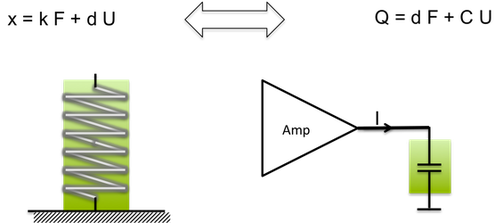
Electrical Behavior of Piezo Actuators
Piezoelectric actuators exhibit electrical behavior similar to capacitors. This behavior is overlaid with the piezoelectric effect, which couples mechanical and electrical states.

To gain an overview of the required electrical power flows in a piezo actuator, a calculation assuming a constant electrical capacitance is sufficient in most cases. The known equation for the current flow through a capacitor is: I = C ⋅ d V d t I=C⋅ dt dV Where: I I is the current flowing through the capacitor, C C is the capacitance, and d V d t dt dV is the rate of change of voltage with respect to time.
I = C d / dt U
For a sinusoidal wave with amplitude U U and frequency f f, the amplitude of the current I I can be determined as follows:
I = 2 PI f C U
These formulas are helpful in choosing the right amplifier. The influence of temperature and signal strength (large signal behavior) is significant, and as a rule of thumb, an increase in capacitance by a factor of two can be assumed to obtain a good estimate of the current. Additionally, the deformation of the piezo causes a displacement of internal charges, resulting in an additional current that overlays with the capacitor current.Diese Formeln sind hilfreich, um den richtigen Verstärker zu wählen. Der Einfluss der Temperatur und der Signalstärke (Großsignalverhalten) ist signifikant und als Faustregel kann eine Erhöhung der Kapazität um einen Faktor Zwei angesetzt werden, um einen guten Schätzwert für den Strom zu erhalten. Zudem bewirkt die Verformung des Piezos eine Verschiebung der inneren Ladungen woraus ein zusätzlicher Strom resultiert, der sich mit dem Kondensatorstrom überlagert.
Eletric Power Demand
For selecting the right amplifier and sizing the power supply, defining the peak current and the continuous power is necessary. The peak current I p I p depends on the maximum speed of the actuation movement. Generally, the stroke of a piezo is approximately proportional to the voltage U U:Für die Auswahl des richtigen Verstärkers und zur Dimensionierung der Stromversorgung ist die Definition des Spitzenstromes und die Dauerleistung nötig. Der Spitzenstrom Ip ist von der maximalen Geschwindigkeit der Stellbewegung abhängig. Im Allgemeinen ist der Hub eines Piezos in erster Näherung proportional zu der Spannung U:
X = deff U
Where d eff is the effective piezoelectric material constant (charge constant). The velocity of displacement V V is proportional to the time derivative of the voltage:
V = deff d / dt U
The current flowing through a capacitor is proportional to the time derivative of the voltage. The current is proportional to the displacement velocity dX/dt
Example
A piezo actuator with dimensions of 5x5x18 mm^3 generates a maximum displacement of 17 micrometers at 150 V.
The capacitance C C of the stack is 1.4 microfarads. When the piezo is charged to 150 V, a charge Q Q flows, considering a factor of 2 for large signal behavior:
Q = 2 x 1,4 uF 150 V = 0,42 mAs
The required current to position the stack in 5 ms is:
I = 0,420 mAs/ 5 10-3s = 84 mA
If higher dynamics are required, for example, to position the same piezo actuator within 500 ms, a correspondingly higher current I 2 I 2 is needed:
I2 = 0,420 mAs/ 500 10-6s = 840 mA
Electrical behavior of piezo actuators - Power dissipation
Like any other electrical component, operating piezoelectric actuators results in losses of electrical energy, which dissipate as heat. Typically, the calculation of losses is done using a loss factor tan δ tanδ or an equivalent series resistance (ESR). In alternating current theory, the dielectric loss factor is defined as follows:
tan delta := ESR 2 Pi f C
For piezoelectric actuators, the loss factor varies with the voltage amplitude due to their pronounced large signal behavior. For small amplitudes, such as a few volts, the damping effect is quite low, and the loss factor
tan
δ
tanδ typically stands at around 1%. In large signal operation, for instance, full amplitude operation between -30 to 150 V, the loss factor typically rises to about 10%. Square wave operation causes even greater losses, up to 20%. A significant advantage of piezoelectric actuators is that in static operation (constant voltage or position), losses remain extremely low even under maximum static loads. Only a small leakage current flows. This is a major advantage over electromagnetic actuators, which consume significant power to generate holding force during holding operation and heat up as a result.